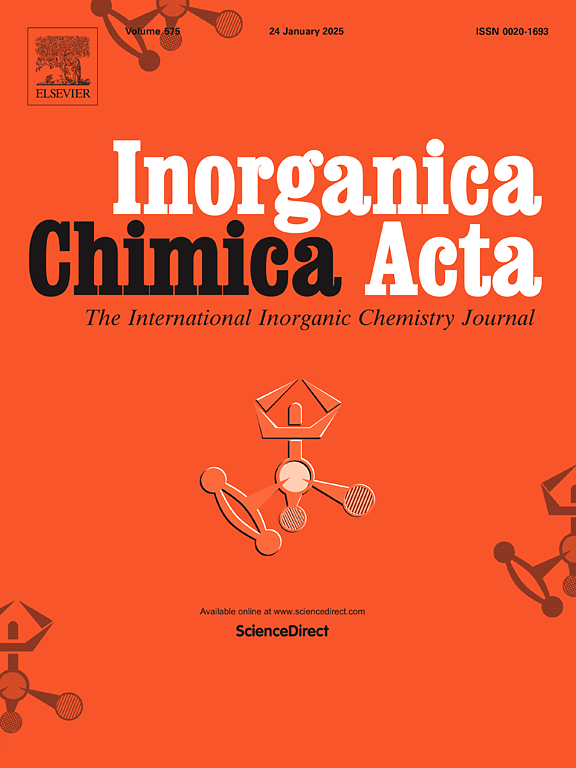Design and environmental security application of a cd(II) coordination polymer: Degradation and sensing of nitroaromatic compounds
IF 3.2
3区 化学
Q2 CHEMISTRY, INORGANIC & NUCLEAR
引用次数: 0
Abstract
The development of functional coordination polymer with photocatalytic capabilities has gained attention for environmental cleanup and security applications. Here, we reported the synthesis, structural characterization, and photocatalytic activity of a Cd(II) coordination polymer, [Cd(L)(Im)]n (H₂L = 4,4′-{(1,2-phenylenebis(methylene)bis(oxy)}dibenzoic acid and Im = Imidazole) (1), designed for the visible-light-driven degradation and sensing of nitro-aromatic compounds. CP 1 was synthesized hydrothermally using and characterized by single-crystal XRD, FT-IR, UV–Vis spectroscopy, PXRD, and TGA. Photocatalytic studies show that 1 effectively sensing of nitroaromatic compounds such as m-nitrophenol (MNP), sodium p-nitrophenol (SNP), and 4-nitrotoluene (PNT) at ppb levels, following pseudo-first-order kinetics. Mechanistic investigations suggest that superoxide radicals (O₂•-) play a key role in the degradation process. Additionally, recyclability tests confirm the material's stability and reusability. This work highlights the potential of Cd(II)-based coordination polymers as efficient and reusable photocatalysts for environmental and security applications.

cd(II)配位聚合物的设计与环境安全应用:硝基芳香族化合物的降解与传感
具有光催化性能的功能配位聚合物在环境净化和安全方面的应用日益受到人们的关注。本文报道了一种Cd(II)配位聚合物[Cd(L)(Im)]n (H₂L = 4,4′-{(1,2-苯基双(亚甲基)双(氧)}二苯甲酸和Im =咪唑)(1)的合成、结构表征和光催化活性,该配位聚合物被设计用于可见光降解和检测硝基芳香族化合物。采用水热法合成了cp1,并通过单晶XRD、FT-IR、UV-Vis、PXRD和TGA对其进行了表征。光催化研究表明,1能在ppb水平下有效地感应到间硝基酚(MNP)、对硝基酚钠(SNP)和4-硝基甲苯(PNT)等硝基芳香族化合物,并遵循准一级动力学。机理研究表明,超氧自由基(O₂•-)在降解过程中起关键作用。此外,可回收性测试证实了材料的稳定性和可重复使用性。这项工作突出了Cd(II)基配位聚合物作为环境和安全应用中高效和可重复使用的光催化剂的潜力。
本文章由计算机程序翻译,如有差异,请以英文原文为准。
求助全文
约1分钟内获得全文
求助全文
来源期刊

Inorganica Chimica Acta
化学-无机化学与核化学
CiteScore
6.00
自引率
3.60%
发文量
440
审稿时长
35 days
期刊介绍:
Inorganica Chimica Acta is an established international forum for all aspects of advanced Inorganic Chemistry. Original papers of high scientific level and interest are published in the form of Articles and Reviews.
Topics covered include:
• chemistry of the main group elements and the d- and f-block metals, including the synthesis, characterization and reactivity of coordination, organometallic, biomimetic, supramolecular coordination compounds, including associated computational studies;
• synthesis, physico-chemical properties, applications of molecule-based nano-scaled clusters and nanomaterials designed using the principles of coordination chemistry, as well as coordination polymers (CPs), metal-organic frameworks (MOFs), metal-organic polyhedra (MPOs);
• reaction mechanisms and physico-chemical investigations computational studies of metalloenzymes and their models;
• applications of inorganic compounds, metallodrugs and molecule-based materials.
Papers composed primarily of structural reports will typically not be considered for publication.
 求助内容:
求助内容: 应助结果提醒方式:
应助结果提醒方式:


